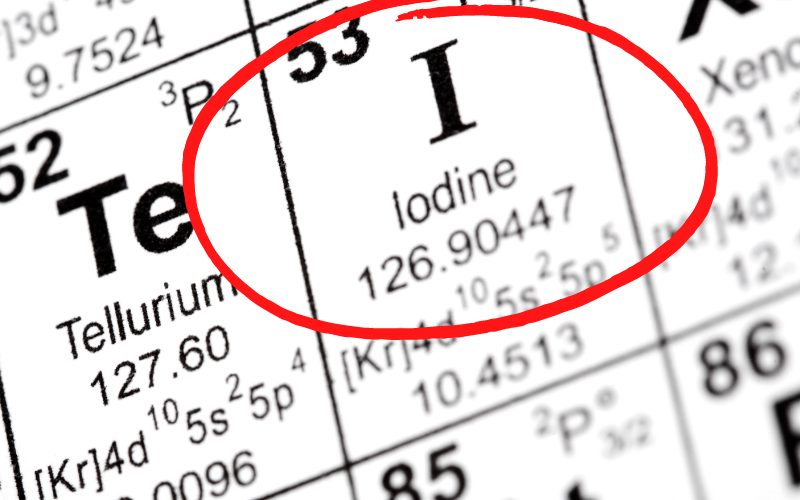Did you know that our body contains between 20 and 50 mg of iodine?
This trace element is present in our tissues, particularly in the thyroid. Indeed, of the 20 to 50 mg contained in an adult male, 50% are concentrated in this endocrine gland. The role of iodine is, therefore, closely linked to the activity of the thyroid (1).
While the body contains iodine, it cannot make iodine by itself. Like all minerals, iodine is considered an essential nutrient which must be provided through the diet. The recommended dietary allowances are summarized int the table below (2).

What are the roles of iodine?
Iodine is an essential nutrient for mammals, required as a structural and functional component of thyroid hormones. Through these hormones, iodine is involved in numerous structures and functions of the body :
- Plays a fundamental role in carbohydrate and lipid homeostasis and energy metabolism.
- Acts on the expression of genes during embryogenesis and growth, as well as on the development of neurological and cognitive functions.
- Functions in the optimal health of skin and appendages (3, 4, 5).
What are the symptoms of iodine deficiency?
Even mild iodine deficiency can have various consequences (5):
- Cramps, muscular pain and joint stiffness;
- Fatigue, drowsiness;
- Constipation;
- Impaired immunity;
- Hormonal imbalance, irregular periods, loss of libido;
- Memory and mood effects;
- Weight gain;
- Hair thinning;
- Cold hands and feet.
Categories linked to iodine deficiencies
You may be more likely to experience some of these symptoms of iodine deficiency if you recognize yourself in one of the categories below (5, 6):
- Sex : Several studies have shown that women over 40 are more affected by thyroid disease than men, in whom the onset occurs later.
- Age : The incidence of hypothyroidism increases with age.
- Geographical area: People at risk of hypothyroidism are all those who live more than 10 km (6 miles) away from the sea due to a lack of iodine.
- Environmental impact and endocrine disruptors: Fluorine, bromine and chlorine are pollutants that persist in the environment and are found in food, mainly fish, seafood and poultry. They are direct competitors of iodine, and their intake prevents its fixation within thyroid hormones.
- Diet:
- Vegetarian diet: Aside from seaweeds and iodized salt, the richest food sources of iodine are animal-derived, such as marine fish, shellfish, egg yolk, and milk.4 This makes it more difficult for people on a strict vegetarian/vegan diet to meet their daily iodine requirements.
- Goitrogenic foods: These foods, including cassava, cauliflower, Brussel sprouts, broccoli, turnip and cabbage, may prevent iodine binding and can worsen the effects of any deficiency.7
- Soy isoflavones: While famous for relieving menopausal symptoms, they may inhibit the activity of an enzyme involved in synthesizing thyroid hormones.
- Periods of life during which the risk of deficiency is exacerbated:
- Early pregnancy: The mother’s thyroid hormones ensure the development of the fetus’s brain, which before the 5th month does not yet produce its hormones. In early pregnancy, estrogen levels increase, negatively impacting thyroid hormone production. The need for iodine in early pregnancy is therefore greater.
- Menopause: This intense period of hormonal changes is often associated with changes in thyroid hormone production, which may exacerbate menopause symptoms.
- Chronic stress: An excess of cortisol alters the production of thyroid hormones.
- Contraception method: Some oral contraceptives or hormone replacement therapy can negatively impact the thyroid.
- Smoking: Smoking while breastfeeding may decrease the amount of iodine passing into the breast milk, which could affect the baby’s thyroid function.
Iodine allergy, myth or reality?
The belief of iodine allergy has spread widely, including into the medical profession. The reason for that belief is that some people are allergic to products containing iodine derivatives. For example, people may be allergic to seafood that naturally contains a lot of iodine. However, their allergy is directed to the proteins in the food, not the iodine.
Another example is skin disinfectant betadine may induce a rash in some people. There again, it is the carrier molecule (polyvinylpyrrolidone) that induces the allergy. There are also allergies to iodinated contrast products (products injected during radiological examinations) (8).
Iodine is an essential component of thyroid hormones: thyroxine (T4) and triiodothyronine (T3), so it is impossible to be allergic to it.
Conclusion
Iodine is a trace element essential for human health. It has several vital roles, including as a structural and functional component of thyroid hormones.
Iodine deficiency can cause serious health problems, so it is essential to ensure adequate levels of iodine through alimentation or supplements.
InnoVactiv has a recognized expertise in developing specialized extracts from natural ingredients. We are proud to offer products that help ensure your customers get the iodine they need daily.
Would you be interested in learning more about our extracts? Contact us.
References
- Alvityl (2020). L’essentiel des minéraux – L’essentiel sur l’iode [online]. Available on: https://alvityl.fr/oligo-elements/iode/
- FDA. Frequently Asked Questions for Industry on Nutrition Facts Labeling Requirements [online]. Available on: https://www.fda.gov/media/99069/download
- EFSA (2014). Scientific opinion on dietary reference values for Iodine [online]. Available on: https://efsa.onlinelibrary.wiley.com/doi/epdf/10.2903/j.efsa.2014.3660
- ANSES (2021). Les références nutritionnelles en vitamines et minéraux. Avis de l’Anses Rapport d’expertise collective, pp.152-157 [online]. Available on: https://www.anses.fr/fr/system/files/NUT2018SA0238Ra.pdf
- Wauquier L. (2021). Les conseils pharma de Léa. Marabout, pp. 184-186
- Passeport Santé (2022). L’hypothyroïdie [online]. Available on: https://www.passeportsante.net/fr/Maux/Problemes/Fiche.aspx?doc=hypothyroidie-pm-personnes-a-risque-d-hypothyroidie
- SCHEIDER W. L. (1985). La Nutrition. McGraw-Hill Editeurs, pp.259-262
- Dewacher P. et Mouton Faivre C. (2015). Presse Med 44 (11), pp 1136-1145
